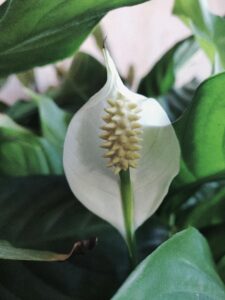Peace Lily Care: How to Care for a Peace Lily
🌸 Introduction
The Peace Lily (Spathiphyllum) is one of the most beloved indoor plants in the United States—and for good reason. It’s elegant, easy to maintain, and an excellent air purifier, according to NASA’s Clean Air Study. Whether you’re a beginner or a seasoned indoor gardener, Peace Lilies offer low-maintenance beauty and a calming presence for any home or office.
These graceful plants are known for their lush green leaves and stunning white spathes (often mistaken for flowers). Peace Lilies thrive in indoor environments and ask for very little in return: just the right amount of light, water, and occasional care.
In this complete care guide, you’ll learn everything you need to grow a thriving Peace Lily—from light and watering tips to common problems and how to encourage blooming. Let’s get started and make your Peace Lily the healthiest plant in your space!
What Is a Peace Lily?
- Botanical Name: Spathiphyllum
- Type: Tropical evergreen, indoor flowering plant
- Native To: Central and South America, Southeast Asia
- Toxicity: Mildly toxic to pets and humans if ingested
Peace Lilies symbolize peace, prosperity, and sympathy, which makes them popular as gifts and memorial plants. Despite the name, they are not true lilies. With the right conditions, they bloom consistently and last for years.

Peace Lily Meaning: Symbolism and Cultural Significance
The Peace Lily (Spathiphyllum) is more than just a beautiful houseplant—it carries deep symbolic meaning and emotional value across different cultures.
What Does the Peace Lily Symbolize?
- Peace & Tranquility:
The most well-known symbolism of the Peace Lily is, as the name suggests, peace. Its soft white blooms and lush green leaves evoke calmness and serenity, making it a symbol of inner peace, purity, and spiritual renewal.
- Sympathy & Remembrance:
Peace Lilies are commonly gifted during times of grief or mourning. They are often seen at funerals or sent to grieving families as a living memorial to symbolize:
- Hope in difficult times
- The soul’s peaceful departure
- Spiritual rebirth
- Hope in difficult times
- Purity & Healing:
The white spathe of the Peace Lily resembles a white flag or a protective veil, symbolizing:
- Purity of heart
- Healing and recovery
- Protection from negative energy
- Purity of heart
- Prosperity & New Beginnings:
In Feng Shui and other spiritual practices, Peace Lilies are believed to bring positive energy, prosperity, and harmonious balance to homes and offices.
Light Requirements for Peace Lily
- Prefers bright, indirect sunlight
- Tolerates low-light conditions but may not bloom
- Avoid direct sunlight—it can scorch the leaves
Best Placement: Near a north or east-facing window, or a few feet away from a south or west-facing one.
Tip: Yellow leaves often signal too much light, while slow growth can mean not enough.

Watering Peace Lily the Right Way
- Water once the top 1 inch of soil feels dry
- Usually once a week in normal conditions
- Use room temperature water
Signs of overwatering:
- Yellow, drooping leaves
- Moldy or soggy soil
Signs of underwatering:
- Wilting leaves that perk up after watering
🪄 Pro Tip: Peace Lilies are dramatic—they’ll droop when thirsty, then bounce back quickly after a drink. Use this as a natural watering cue!
Best Soil and Potting Tips
Peace Lilies need well-draining, airy soil.
Ideal Soil Mix:
- 1 part potting soil
- 1 part perlite or sand
- 1 part peat moss or coconut coir
Pot Tips:
- Choose a pot with drainage holes
- Repot every 1–2 years to refresh soil and give space for roots
Temperature & Humidity Needs
- Temperature: 65°F–85°F (18°C–29°C)
- Humidity: High humidity preferred (50%+)
Avoid cold drafts, sudden temperature drops, or heaters. They prefer a stable, warm environment.
Boost humidity with:
- A pebble tray
- A room humidifier
- Misting (once a week is enough)

How to Encourage Blooming
Peace Lilies bloom with proper light and minimal stress.
To promote flowering:
- Provide bright, filtered light (no direct sun)
- Use a balanced houseplant fertilizer once a month during spring/summer
- Keep the temperature consistent
- Remove faded flowers to redirect energy
🪻 Fact: Peace Lily flowers are actually spathes—leaf-like structures that protect the actual tiny flower cluster inside.
Fertilizing Schedule
- Fertilize every 4–6 weeks during spring and summer
- Use a balanced 20-20-20 liquid fertilizer, diluted to half strength
- Avoid fertilizing in fall and winter
Signs of over fertilizing: Brown leaf tips or yellowing leaves
Common Peace Lily Problems and Fixes
| Problem | Cause | Solution |
| Yellow leaves | Overwatering or too much sun | Water less frequently and adjust light |
| Brown tips | Dry air or overfertilizer | Increase humidity, flush soil |
| No blooms | Not enough light | Move closer to a bright window |
| Drooping | Thirsty or rootbound | Water or repot |
| Pest infestation | Spider mites, mealybugs | Wipe with neem oil or insecticidal soap |
READ ALSO: Indoor Plants Safe for Pets: 15 Beautiful and Non-Toxic Plants
Is Peace Lily Toxic?
Yes. Peace Lilies are toxic to pets and humans if ingested. They contain calcium oxalate crystals, which can cause:
- Drooling
- Mouth irritation
- Vomiting in pets
Safety tip: Keep out of reach of cats, dogs, and small children.

Benefits of Growing a Peace Lily
- Air purification: Removes toxins like benzene and formaldehyde
- Low maintenance: Beginner-friendly care
- Decor impact: Brightens up any room
- Stress relief: Enhances indoor serenity
It’s a top pick for bedrooms, bathrooms, and living rooms.
Frequently Asked Questions (FAQs)
1. How often should I water a peace lily?
Water once the top inch of soil is dry, usually once a week.
2. Why are my peace lily leaves turning yellow?
This is often due to overwatering or poor drainage.
3. Can peace lilies survive in low light?
Yes, but they may bloom less frequently.
4. When should I repot my peace lily?
Every 1–2 years or when the plant outgrows its pot.
5. How do I make my peace lily bloom?
Provide bright, indirect light and feed monthly in spring and summer.
6. Are peace lilies safe for pets?
No. They are mildly toxic to cats and dogs if ingested.
7. What kind of fertilizer should I use?
A balanced 10-10-10 or 20-20-20 houseplant fertilizer is ideal.
8. How do I increase humidity for my peace lily?
Use a humidifier, mist regularly, or place a water tray near the plant.
9. Can I keep peace lilies in the bathroom?
Yes, the natural humidity makes bathrooms an ideal location.
10. How do I clean peace lily leaves?
Gently wipe them with a damp cloth to remove dust.
Conclusion
The Peace Lily is more than just a pretty face—it’s a symbol of calm, health, and resilience. With just a little care, this elegant indoor plant can brighten your home, purify your air, and bloom year after year.
Whether you’re a first-time plant parent or looking to expand your indoor jungle, Peace Lily is the perfect low-maintenance beauty to start with.

